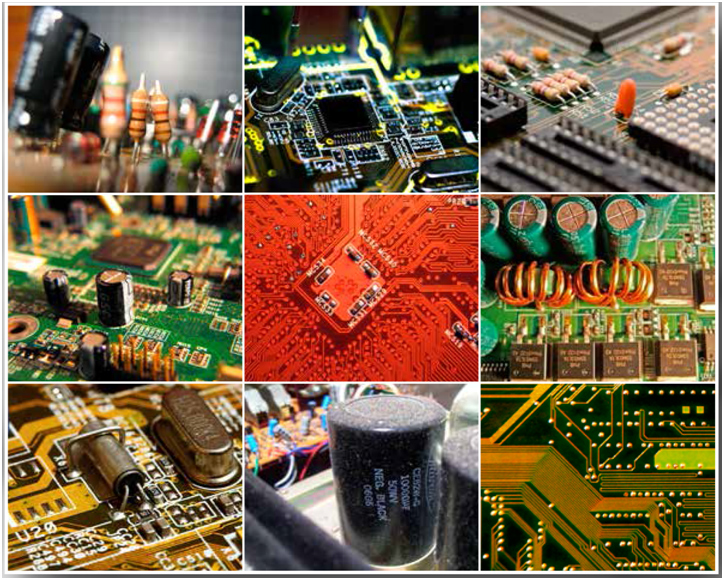Year 2015 will witness a surge increase in the electronics items in Indian market. Increasing trends towards HD will increase consumption of DTH boxes. Mobiles & android devices will book sales of double the figure in 2014. Drastically increasing market of consumable electronics devices has encouraged EMS industry of India to extend manufacturing facilities for local market. In this article ahead, we have bought to you experts view on “New Start-ups in India in 2015“.
Growth of the electronic products market has led EMS companies to offer lower cost of manufacturing, faster turnaround for designs and quicker time to market. Since the mid-nineties, many global EMS companies have established operations in India and have become a key contributor in enhancing the ecosystem in the country. Manufacturing policies such as the Electronics Manufacturing Clusters policy are deemed favorable to the prospects of the EMS industry in India. The burgeoning market for local consumer electronics and select telecom products is also attracting investors into the segment. Emerging segments like medical and aerospace/defense are also expected to the leverage the existing capabilities of the EMS industry. The Indian ESDM industry has proven its mettle by growing against immense adversities. In order to make Indian EMS industry a presence in international market, stakeholders – the industry and the government – have to exhibit the highest level of commitment to bring about change immediately. A number of factors are today working in favor the Indian ESDM industry is as follows. Favored with govt. policies and economical support year 2015 is expected to witness some of the milestones to be set-up by Indian EMS industry. Industry trend to amplify their manufacturing set-ups in India could make our day to day electronics “Made in India”.
Significant size of the domestic electronics product market
Design and manufacturing capabilities
Thrust to entrepreneurship
Availability of skilled and semi-skilled manpower
Global corporations exploring high growth geographies for investment
Recognition of ESDM as a key growth engine for GDP
Amara Raja Electronics Ltd.

Mr. Ramana Prasad Alam, CEO commented on industry prospects for the year 2015. As per Mr. Alam, the consumption of Electronics would further go up due to new initiatives like “MAKE IN INDIA” etc. inviting larger participation from India Inc. in the near future. With the interventions in policy like MSIPS, incentives from few select state governments, the existing players would be encouraged to consider expansion of the current manufacturing facilities in India. Participation of Foreign companies in Indian Electronics market is welcome , as this is supposed to bring in current technology, best –in-class manufacturing practices raising the overall capability of electronics industry. Some of the challenges to the Indian EMS industry are, Availability of right talent, technology in the form of solutions to address the local opportunities and having to import electronic components.
EOS Power India Pvt. Ltd.
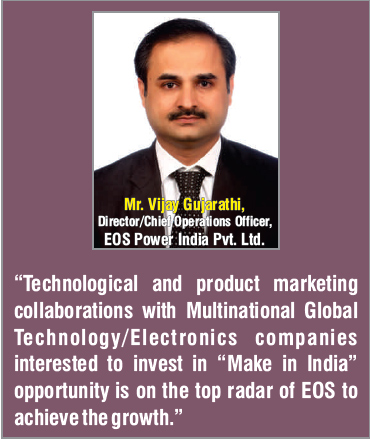
Mr. Vijay Gujarathi, Director/Chief Operations Officer, commented on industry prospects for the year 2015. As per Mr. Gujarathi, Out of the 25 sectors identified by the government, the IT and electronics hardware industry is one of the primary sectors for which the government is adding more impetus. The numbers are certainly telling. India imports electronic items worth US$ 100 billion annually, and this is projected to escalate to US$ 400 billion by 2020. The overall indian market for electronics products from all segments, including consumer electronics, IT/Computers, Telecom, Automotive, and Medical, Strategic etc. expected to be worth US$ 94.2 billion by 2015 with a CAGR of 9.88 per cent between 2011-15. Indian government is giving lot of importance to strengthening the availability of domestic electronics supply chain to encourage manufacturing and reduce dependence in import, to boost the Indian Manufacturers national policy was finalized by Indian government to support the Indian industry. This narrates the great opportunity for Indian Manufacturers and new start ups with objective to:
- To achieve a turnover of about USD 400 Billion by 2020 involving investment of about USD 100 Billion.
- To create employment to around 28 Million people at various levels.
- To increase the export in ESDM sector from USD 5.5 Billion to USD 80 Billion by 2020.
- To significantly enhance availability of skilled manpower in the ESDM sector.
- To create an institutional mechanism for developing and mandating standards and certification for electronic products and services.
EOS’ product design centre and manufacturing facility is based in the SEEPZ-SEZ, Mumbai. The core management team of EOS has been with the company for over 20 years. While the company registered revenue of Rs 782.69 million in FY 2013-14, it is aiming to expand its revenue to Rs 1000 million, by year 2016.
Sahasra Electronics Pvt. Ltd.
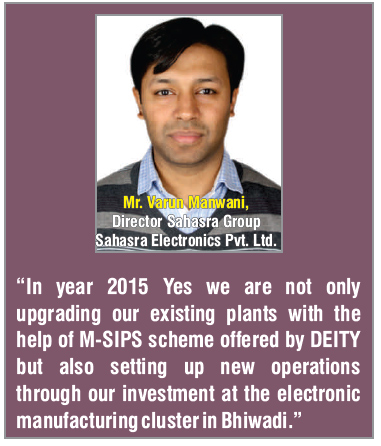
Mr. Varun Manwani, Director, Sahasra Group commented on industry prospects for the year 2015. As per Mr. Manwani, Electronics consumption in Indian market will increase, provided the government is able to change policies to promote manufacturing in India, reduce bureaucratic procedures and work on removal of disabilities faced by the industry in terms of finance costs, transaction costs, etc. The new policies are pro-manufacturing but a lot needs to be done and at a much faster pace. The Department of Electronics and IT is doing a terrific job with focused people like current Joint Secretary Dr. Ajay Kumar and with specific focus directly from the Prime Minister Shri Narendra Modi. There are foreign companies who are interested to invest in India both in terms of a low cost manufacturing base and also in terms of capturing the market. Foreign investment in the EMS industry will help the industry in catching up with the western markets in terms of quality processes and systems, technological advances as well as bring the entire supply chain to India. Some of the challenges to be named are, infrastructure, availability of resources such as water and power and skilled manpower are some of the biggest bottle necks. The government needs to work towards making power, water and housing available to the industry so that the cost of operations are availability of manpower is not an issue. The regulatory and bureaucratic environment needs to changes such as implementation of GST, financial incentives needs to be provided and interest rates need to be reduced drastically. Additionally industries, institutions and the state governments needs to work together to need to work together to bridge the skill gaps and make trained manpower available.
Jabil Circuits
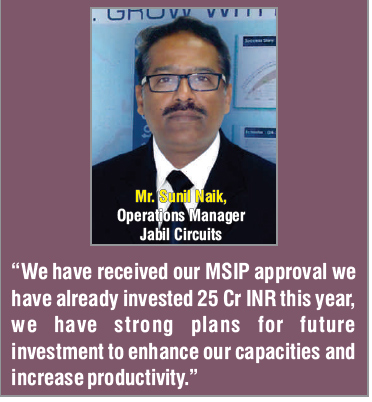
Mr. Sunil Naik, Operations Manager commented on industry prospects for the year 2015. As per Mr. Naik, the past decade has been remarkable for the Indian electronics industry from a consumption perspective: 172 million units in 2010; PCs 8.2 million in 2010; rapidly growing LCD TV market that witnessed sales of 3.5 million units in 2010. The tremendous growth in all segments of electronics has given the industry a key position on the global map. The Indian electronics industry has been growing at a CAGR of over 25 percent in the past 5 years and the major reasons that can be attributed to this growth are. This definitely going to grow local manufacturing in line with the vision set by the PM for “Make in India” vision statement.
- GDP growth rates upside.
- Revival of the global economy
- A rapidly expanding middle class with increasing disposable income.
- Continual decline in prices of most the electronics goods (a camera mobile that cost over Rs.15, 000 five years ago is available for <Rs. 5,000 today)
Raising foreign direct investment cap to at least 51% in the defense sector and 100 % in Medical sector will help India become a major manufacturing and export hub, reducing dependency on imported equipment. Growth oriented environment will boost the local manufacturing and will support the investment opportunities for the companies to believe in growth model. It will initiate more and more proposals to expand capacities and invest in capabilities as well. India’s growing economy offers domestic entrepreneurs and international players many opportunities to invest. The country’s government, realizing the significance of the manufacturing industry to India’s industrial development, has taken necessary steps to increase investment in the sector. India’s manufacturing sector could touch US$ 1 trillion by 2025. The burgeoning demand in the country and the multinational corporations’ desire to establish low-cost plants in India can contribute to this. There is potential for the sector to account for 25-30 per cent of the country’s GDP and create up to 90 million domestic jobs, by 2025. Many more companies like Cisco, GE, Siemens, and Schneider are looking for big step in India to start up their manufacturing activities with full throttle In adequate infrastructure lack of governance and transparency as a major obstacles.
Elin Electronics Limited

Mr. B.S. Sethia, Director commented on industry prospects for the year 2015. As per Mr. Sethia, Growth of demand of electronic products does not necessarily promote setting up of startups, which are normally guided by technologies and disruptive ideas. These will certainly promote new startups. The new government policies, of both the Central and the State governments, will surely motivate companies to extend manufacturing facilities. Last few years inaction of the government policies has created atmosphere of distrust. The guidelines for implementation of these policies were not based on trust. Companies were apprehensive of getting the intended subsidies on time. Companies are required to implement the project by investing money to the extent of the threshold limits in order to get reimbursement of the subsidies. These will only help wealthy companies/individuals rather than the SMEs who cannot arrange full investment upfront. There seem to be movement in investment in the EMS by international companies as this is low value added and comparatively less risky activity. Many companies are waiting for reduction in the threshold limit from Rs. 100 crores to Rs. 10 crores. Setting up a manufacturing hub or cluster is an extremely difficult task. It is basically responsibility of the government, but government can not envisage and establish common facilities required by the units going to be set up in a particular cluster. Private organizations are required to pay the entire cost of land upfront whereas at least 2-3 years are required to get all the permissions and land allotment to actual industrial unites. Most of the companies cannot wait for so long in getting the land allotment after making payments. The Special Purpose Companies (SPV) in the the PPP mode having land as government’s contribution seem to be more practical business model for setting up such clusters. Elin Electronics Limited, has plans to set up new plant as substantial expansion in 2015 at our Ghaziabad unit apart from participating in the Elcina Electronic Manufacturing Cluster at Bhiwadi, Rajasthan.
Smile Electronics Ltd.
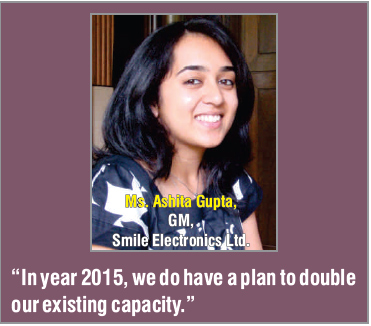
Ms. Ashita Gupta, GM, Operations commented on industry prospects for the year 2015. As per Ms. Ashita, yes, electronics consumption in Indian market is increasing drastically and Govt. policies will be in favor of industry in year 2015. On foreign investment, the manufacturing sector should attract major multinationals into the country. The govt. still needs to do a lot more to make it attractive like land availability/ capex availability/ stable power/ labor policy reforms.
Agate & Agate Marketing Resources (I) Pvt Ltd

Mr. Ashutosh Agate, Managing Director commented on industry prospects for the year 2015. As per Mr. Agate, Electronics consumption in Indian market is increasing drastically, as electronics consumption in India is increasing exponentially & currently lot of this is imported. This surely makes a case for several start-ups joining the electronics hardware manufacturing only if young entrepreneurs are passionate enough about hardware manufacturing business. Government policies when effectively implemented at ground level which essentially means sound infrastructure and robust ecosystem will surely motivate manufacturers to expand their facilities here. The ever increasing home consumption alone makes a case for local manufacturing. As has been heard recently some leading Chinese Mobile Phone manufacturers are upbeat about starting manufacturing in India and many others may follow. EMS industry in India is way behind EMS industry in China and many other countries. There are very few Indian EMS players who can boast of world class facilities & scales. One of the several reasons for this situation is price sensitive Indian customer which makes it difficult for small-medium EMS player to invest for further up gradation of the existing facilities. So unless such issues are addressed effectively and solutions found it will be difficult for foreign investor to fetch descent returns on their investment. However if foreign investment can come with goods and services buy-back arrangements surely the scenario will change for those companies as well as for the industry. There are numerous hurdles right from the infrastructure to the cost of capital. We established just over a year ago the state-of-the-art facility to Design-Test-Manufacture LED Lights Products such as Light Engines & LED Lights fixtures. We shall upgrade this facility to further augment our LED Photometry Testing capabilities and also plan to add environmental testing facilities for LED Lights fixtures.
Conclusion
It is very encouraging to see increased focus on the ESDM sector in last couple of years and a significant amount of work was done to bring out National Electronics Policy and National Telecom Policy by the government in consultation with industry. Some of the initiatives outlined in these policies are already in process of implementation such as Preferential Market Access (PMS), Electronics Manufacturing Clusters (EMC) and Modified SIPS.




